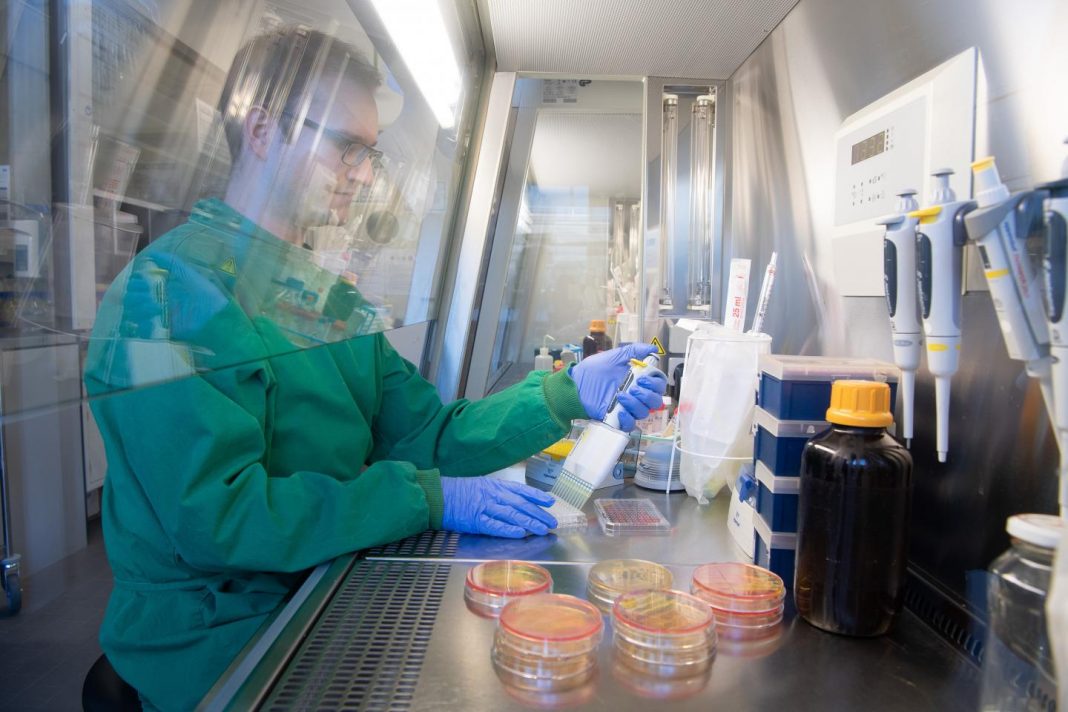A team of scientists at the Technical University of Munich (TUM) and the Helmholtz Center for Infection Research (HZI) in Braunschweig have chemically modified an approved cancer drug into a prototype antibiotic that is effective against multidrug-resistant (MDR) pathogens, including strains of the superbug, methicillin-resistant Staphylococcus aureus (MRSA). Tests showed that the modified drug, known as PK150, was effective in mice with bloodstream infections, and did not induce resistance in laboratory-grown bacteria.
“The industrial development of new antibiotics is stalling and not keeping pace with the spread of antibiotic resistance,” said Eoncova Medina, PhD, director of the HZI infection immunology research group. “We urgently need innovative approaches to meet the need for new infection therapies that do not lead directly to renewed resistance.” Medina is co-author of the researchers’ published paper in Nature Chemistry, which is titled, “Repurposing human kinase inhibitors to create an antibiotic active against drug-resistant Staphylococcus aureus, persisters, and biofilms.”
The current treatment of bacterial infections is challenged by a dramatic increase of multidrug-resistant strains, the authors wrote. “In addition to infections caused by Gram-negative MDR pathogens, Gram-positive pathogens, such as Staphylococcus aureus, remain among the top causes of healthcare-associated infections, with a high priority in drug development.” MRSA is the cause of severe and persistent infections, and some strains are resistant to multiple antibiotics.
Almost all marketed antibiotics target bacterial cell wall biosynthesis, membrane integrity, DNA synthesis, or protein biosynthesis, but bacteria have developed a range of resistance mechanisms that can thwart just about every drug developed. One promising strategy for new antimicrobial drug development is to test drugs that have been approved for other indications, for any potential antibacterial effects. “Given the drought in the discovery of new antibiotics on the one hand and the large number of about 300 bacterial proteins with predicted essential function on the other, mining bacterial proteomes with known drugs for untargeted pathways represents an attractive strategy to unravel new and resistance-free drug candidates,” the scientists commented.
“Our focus was on a class of human proteins, called kinases, which have many inhibitors to begin with,” explained study leader Stephan Sieber, PhD, professor of organic chemistry at TUM. “Research into drugs directed against essential bacterial kinases is still in its infancy, and a wealth of eukaryotic kinase inhibitors, originally developed to fight cancer, awaits bacterial testing and putative drug repurposing,” the authors stated.
The team’s starting point was the marketed anticancer drug sorafenib (SFN), which prior studies have shown is effective against MRSA. What hasn’t been understood so far is whether the bacterial target of SFN is a kinase. Sieber and colleagues chemically modified the sorafenib molecule to achieve an even stronger antibiotic effect. Out of dozens of synthesized molecules PK150 was found to be ten times more effective against MRSA than sorafenib itself. The new molecular structure was also more effective than either vancomycin or linezolid against one strain of S. aureus tested, and, unlike SFN, could also kill the superbug vancomycin-resistant VRE, against which there are now very few effective antibiotics.
The researchers’ tests didn’t identify any known kinases as targets of the new drug, but demonstrated that of a number of potential targets, PK150 interfered with the synthesis of bacterial menaquinone, which is vital for bacterial respiration and energy metabolism—and also caused dysregulation of protein secretion. “As a result of the chemical changes to the molecule, PK150 no longer binds to human kinases, but acts very specifically against bacterial targets,” said Sieber.
In contrast to antibiotics such as penicillin and methicillin, which interfere with cell wall formation, PK150 was found to act indirectly, knocking bacterial protein production out of kilter, and causing the bacteria to release more proteins that control the cell wall thickness to the outside, which ultimately results in the cells bursting.
In mice, PK150 was effective against MRSA in a variety of tissues. “In comparison to the marketed antibiotic LVX [levofloxacin] as the benchmark control, PK150 exhibited not only an equal potency but also convenient dosing intervals of up to two days and good bioavailability,” the team noted. And while staphylococci will rapidly develop resistance other antibiotics, the researchers didn’t witness the development of any resistance to PK150 in lab-grown bacteria. “Although the control antibiotic ofloxacin and SFN exhibited a rapid drop in antibacterial activity after a few passages, PK150 remained active over the complete course of the study,” they stated.
Medina and Katharina Rox, PhD, a pharmacologist from the department of chemical biology at HZI, showed that PK150 also has favorable pharmacological properties. It can be administered as an oral tablet, for example, and remains stable in the body for several hours. And PK150 could also feasibly tackle the most persistent of infections. “PK150 fully eradicated persister cells,” the investigators stated. “In addition, staphylococcal biofilms, largely composed of persisters, were effectively eradicated on PK150 treatment (80% reduction in biofilm after 24 hours of treatment), whereas the antibiotic vancomycin did not significantly affect biofilm integrity.” Dietmar Pieper, PhD, head of the HZI microbial interactions and processes research group, further commented, “MRSA infections are very often chronic, as the bacteria can become dormant. PK150 even kills these, as well as germs protected in biofilms.”
In the context of the aBACTER project, Sieber’s team is now further optimizing PK150 with a view to future clinical development. “Ongoing medicinal chemistry studies are being performed to further optimize the solubility, toxicity, and spectrum of addressed bacteria to further exploit the antibiotic potential of this promising drug candidate in preclinical disease models,” the researchers noted.


